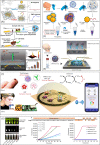Nanodiagnostics to Face SARS-CoV-2 and Future Pandemics: From an Idea to the Market and Beyond
- PMID: 34705433
- PMCID: PMC8565461
- DOI: 10.1021/acsnano.1c06839
Nanodiagnostics to Face SARS-CoV-2 and Future Pandemics: From an Idea to the Market and Beyond
Abstract
The COVID-19 pandemic made clear how our society requires quickly available tools to address emerging healthcare issues. Diagnostic assays and devices are used every day to screen for COVID-19 positive patients, with the aim to decide the appropriate treatment and containment measures. In this context, we would have expected to see the use of the most recent diagnostic technologies worldwide, including the advanced ones such as nano-biosensors capable to provide faster, more sensitive, cheaper, and high-throughput results than the standard polymerase chain reaction and lateral flow assays. Here we discuss why that has not been the case and why all the exciting diagnostic strategies published on a daily basis in peer-reviewed journals are not yet successful in reaching the market and being implemented in the clinical practice.
Keywords: COVID-19; SARS-CoV-2; biosensors; bottlenecks; nanodiagnostics; outbreaks; phases of test development; testing methods.
Conflict of interest statement
The authors declare no competing financial interest.
Figures



References
-
- Holshue M. L.; DeBolt C.; Lindquist S.; Lofy K. H.; Wiesman J.; Bruce H.; Spitters C.; Ericson K.; Wilkerson S.; Tural A.; Diaz G.; Cohn A.; Fox L.; Patel A.; Gerber S. I.; Kim L.; Tong S.; Lu X.; Lindstrom S.; Pallansch M. A.; et al. First Case of 2019 Novel Coronavirus in the United States. N. Engl. J. Med. 2020, 382 (10), 929–936. 10.1056/NEJMoa2001191. - DOI - PMC - PubMed
Publication types
MeSH terms
LinkOut - more resources
Full Text Sources
Medical
Miscellaneous

